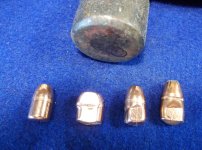Greetings!
I have little experience reloading plated bullets. My experience is limited to the Speer 200gr TMJSWC that I use for CMP matches.
I have an order of plated bullets (Xtreme 9mm 124gr FN) on the way, since bulk plated bullets seem easier to find (today) than bulk jacketed bullets!
My question: how do plated bullets perform compared to (full metal) jacketed bullets? Do they tend to offer more or less resistance than jacketed bullets when moving through the bore of a pistol? Can I presume that a plated bullet compared to a jacketed bullet will require less powder in order to achieve a similar velocity?
As always, thanks in advance for your help!
I have little experience reloading plated bullets. My experience is limited to the Speer 200gr TMJSWC that I use for CMP matches.
I have an order of plated bullets (Xtreme 9mm 124gr FN) on the way, since bulk plated bullets seem easier to find (today) than bulk jacketed bullets!
My question: how do plated bullets perform compared to (full metal) jacketed bullets? Do they tend to offer more or less resistance than jacketed bullets when moving through the bore of a pistol? Can I presume that a plated bullet compared to a jacketed bullet will require less powder in order to achieve a similar velocity?
As always, thanks in advance for your help!

